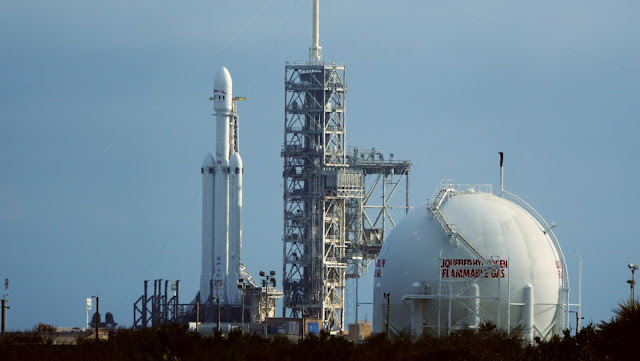Chandrayaan-2
This is a mission being conducted by the Indian Space Research Organization and is slated to launch in March. It will consist of a lunar orbiter, lander and rover. The scientific payloads will have a variety of different spectrometers, cameras and radar. The 44 pound rover will be able to perform chemical analysis of the Moon's surface and relay it back to the orbiter. Also, using radar it is hoped that further evidence can be provided for water ice throughout regions of the Moon.
 |
| Chandrayaan-2 (Image Credit: India Today) |
Chang'e 4
China is anticipating launching a lunar orbiter during the Summer of 2018. Late in 2018 or early 2019 they will deploy a lander with a rover on the far side of the Moon. Anticipated to land in the crater known as Von Kármán in the South Pole-Aitken Basin. This will be the first landing on the far side of the moon, a vastly unexplored region. With a significant payload of scientific instruments the outcome of this mission is quite positive. The lander will also contain potato seeds and silkworm eggs. The idea is to have the carbon dioxide from the worms sustain the plants while the oxygen will sustain the worms. Possibly by 2019 the Chang'e 5 mission will return the first lunar samples back to Earth since 1976.
 |
| Chinese Yutu Rover on the Moon (Image Credit: CSNA) |
Space-X Falcon Heavy
This mission has received a lot of media attention over the past few weeks. The anticipated launch date is January 2018. Space-X is looking to launch their Falcon Heavy from Complex 39A; the most powerful rocket launch from there since the legendary Saturn V. The inaugural payload will be a Tesla Roadster on a trajectory towards Mars. If successful it is anticipated a manned mission will send space tourists on a flight to see the Moon. Harnessing Space-X's capacity for reusing rockets the three Falcon 9 cores will return to Earth to be used again. A huge rocket, it will have a payload capacity close to 150,000 pounds!
 |
| Falcon Heavy on 39A (Image Credit: NSF, Derrick Stamos) |
Juno
Juno has been orbiting Jupiter since July 5, 2016 and has provided the world with many amazing pictures and scientific data. The mission is planned to last until July 16, 2018 when its primary mission comes to an end. However, based on funding, it may be extended for another 3 years. At the end of the mission, much like Cassini, it will be placed in a controlled deorbit to burn up in the atmosphere of Jupiter.
 |
| Juno (Image Credit: NASA) |
TESS
The transiting exoplanet survey satellite is a space telescope anticipated to launch in March. With state of the art CCD cameras TESS will search for exoplanet candidates based on the transit method. As an exoplanet transits the face of its star it causes a measurable dip in the magnitude of observable light. As an added bonus it will also seek transient stellar activity such as gamma ray bursts. Nearly half a million stars will be analyzed and it is hoped that planets similar to Earth will be found in the habitable zone of the target stars. TESS will also act as a prequel to the James Webb Space Telescope by developing a list of targets that will be examined further.
 |
| TESS (Image Credit: MIT) |
Insight
This will be the only mission travelling to Mars during this opposition window. The next window will be in 2020. Due to the orbits of Earth and Mars, missions are only launched when the planets are on the same side of the Sun to each other. This mission consists of a lander that will be stationary on the surface of the red planet. It will have a sensitive seismometer and a burrowing heat probe that can go five meters below the surface. It will also be equipped with a interior structure experiment that will narrow down the density of our rocky neighbour. Launching in May of 2018, it is projected to have a mission length of 2 years.
 |
| InSight (Image Credit: NASA/JPL-Caltech) |
Parker Solar Probe
A mission to the Sun will launch during the middle of the northern hemisphere Summer from Cape Canaveral. With a mission duration of nearly 7 years we should get some really good data about our own star. At its closest approach it will be only 6 million kilometers from the Sun. For general reference, the closest Mercury gets to the Sun is 46 million kilometers. At approximately 8.5 solar radii the Parker Solar Probe will study the solar wind at its source. By learning more about space weather we will be better able to protect the Earth and satellites in orbit from solar radiation.
 |
| Parker Space Probe (Image Credit: John Hopkins University Applied Physics Laboratory) |
BepiColombo
A joint venture between the European Space Agency and the Japanese Aerospace Exploration Agency to the planet Mercury. Set to launch in October 2018 it is slated to arrive at our Solar System's smallest planet in 2025. It will consist of two orbiters, a planetary orbiter and a magnetospheric orbiter. The main goals of this mission is to analyze the geology and evolution of Mercury. Also, it is designed to investigate Mercury's tenuous atmosphere which will provide insight into the atmosphere of planets close to their home star. Russia is providing spectrometers that will be used to look for water in polar craters that do not face the Sun.
 |
| BepiColombo (Image Credit: Astrium) |

0 comments:
Post a Comment